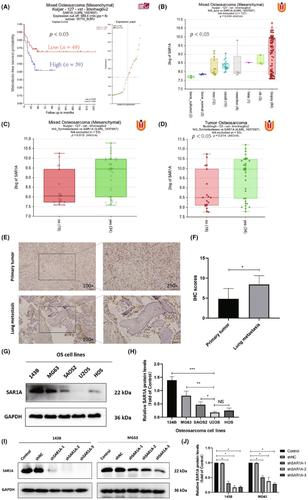当前位置:
X-MOL 学术
›
Cancer Sci.
›
论文详情
Our official English website, www.x-mol.net, welcomes your feedback! (Note: you will need to create a separate account there.)
SAR1A regulates the RhoA/YAP and autophagy signaling pathways to influence osteosarcoma invasion and metastasis
Cancer Science ( IF 5.7 ) Pub Date : 2022-09-01 , DOI: 10.1111/cas.15551 Fangbiao Zhan 1, 2, 3 , Qianrong Deng 4 , Zhiyu Chen 2, 3 , Chaozheng Xie 5 , Shuang Xiang 6 , Sheng Qiu 7 , Lin Tian 8 , Chunrong Wu 9 , Yunsheng Ou 2, 3 , Jian Chen 1 , Lixin Xu 1
Cancer Science ( IF 5.7 ) Pub Date : 2022-09-01 , DOI: 10.1111/cas.15551 Fangbiao Zhan 1, 2, 3 , Qianrong Deng 4 , Zhiyu Chen 2, 3 , Chaozheng Xie 5 , Shuang Xiang 6 , Sheng Qiu 7 , Lin Tian 8 , Chunrong Wu 9 , Yunsheng Ou 2, 3 , Jian Chen 1 , Lixin Xu 1
Affiliation

|
Osteosarcoma is the most prevalent form of primary bone malignancy affecting adolescents. Secretion-associated Ras-related GTPase 1A (SAR1A) is a key regulator of endoplasmic reticulum (ER) homeostasis, but its role as a regulator of osteosarcoma metastasis has yet to be clarified. Bioinformatics analyses revealed SAR1A and RHOA to be upregulated in osteosarcoma patients, with the upregulation of these genes being associated with poor 5-year metastasis-free survival rates. In addition, the upregulation of SAR1A and RHOA in osteosarcoma was highly positively correlated. Immunohistochemical analyses additionally revealed that SAR1A levels were increased in osteosarcoma pulmonary metastases. In vitro wound healing and Transwell assays indicated that knocking down SAR1A or RHOA impaired the invasive and migratory activity of osteosarcoma cells, whereas RHOA overexpression had the opposite effect. Western blotting and immunofluorescent staining revealed the inhibition of osteosarcoma cell epithelial–mesenchymal transition following SAR1A or RHOA knockdown; RHOA overexpression had the opposite effect. Following SAR1A knockdown, phalloidin staining indicated that osteosarcoma cells showed reduced lamellipodia formation. Endoplasmic reticulum stress levels and reactive oxygen species production were enhanced following the knockdown of SAR1A, as was autophagic activity, with lung metastases being reduced in vivo after such knockdown. Knocking down SAR1A suppresses osteosarcoma cell metastasis through the RhoA/YAP, ER stress, and autophagic pathways, offering new insights into the regulation of autophagic activity in the context of osteosarcoma cell metastasis and suggesting that these pathways could be amenable to therapeutic intervention.
中文翻译:

SAR1A调控RhoA/YAP和自噬信号通路影响骨肉瘤侵袭转移
骨肉瘤是影响青少年的最普遍的原发性骨恶性肿瘤。分泌相关 Ras 相关 GTP 酶 1A (SAR1A) 是内质网 (ER) 稳态的关键调节因子,但其作为骨肉瘤转移调节因子的作用尚待阐明。生物信息学分析显示SAR1A和RHOA在骨肉瘤患者中上调,这些基因的上调与 5 年无转移生存率低有关。此外,SAR1A和RHOA的上调在骨肉瘤中呈高度正相关。免疫组织化学分析还表明,SAR1A 水平在骨肉瘤肺转移瘤中增加。体外伤口愈合和 Transwell 测定表明,敲低 SAR1A 或 RHOA 会损害骨肉瘤细胞的侵袭和迁移活动,而 RHOA 过表达则具有相反的效果。蛋白质印迹和免疫荧光染色显示 SAR1A 或 RHOA 敲低后骨肉瘤细胞上皮-间质转化受到抑制;RHOA 过表达具有相反的效果。在 SAR1A 敲低后,鬼笔环肽染色表明骨肉瘤细胞的片状伪足形成减少。内质网应激水平和活性氧的产生在 SAR1A 敲低后增强,自噬活性也是如此,在这种敲除后肺转移在体内减少。敲低 SAR1A 通过 RhoA/YAP、ER 应激和自噬途径抑制骨肉瘤细胞转移,为骨肉瘤细胞转移背景下自噬活性的调节提供了新的见解,并表明这些途径可能适用于治疗干预。
更新日期:2022-09-01
中文翻译:

SAR1A调控RhoA/YAP和自噬信号通路影响骨肉瘤侵袭转移
骨肉瘤是影响青少年的最普遍的原发性骨恶性肿瘤。分泌相关 Ras 相关 GTP 酶 1A (SAR1A) 是内质网 (ER) 稳态的关键调节因子,但其作为骨肉瘤转移调节因子的作用尚待阐明。生物信息学分析显示SAR1A和RHOA在骨肉瘤患者中上调,这些基因的上调与 5 年无转移生存率低有关。此外,SAR1A和RHOA的上调在骨肉瘤中呈高度正相关。免疫组织化学分析还表明,SAR1A 水平在骨肉瘤肺转移瘤中增加。体外伤口愈合和 Transwell 测定表明,敲低 SAR1A 或 RHOA 会损害骨肉瘤细胞的侵袭和迁移活动,而 RHOA 过表达则具有相反的效果。蛋白质印迹和免疫荧光染色显示 SAR1A 或 RHOA 敲低后骨肉瘤细胞上皮-间质转化受到抑制;RHOA 过表达具有相反的效果。在 SAR1A 敲低后,鬼笔环肽染色表明骨肉瘤细胞的片状伪足形成减少。内质网应激水平和活性氧的产生在 SAR1A 敲低后增强,自噬活性也是如此,在这种敲除后肺转移在体内减少。敲低 SAR1A 通过 RhoA/YAP、ER 应激和自噬途径抑制骨肉瘤细胞转移,为骨肉瘤细胞转移背景下自噬活性的调节提供了新的见解,并表明这些途径可能适用于治疗干预。



























 京公网安备 11010802027423号
京公网安备 11010802027423号